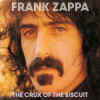 simon prentis
simon prentis simon prentis
simon prentis
random notes
Reprinted from "Zappa!", published in '92 by
Keyboard and Guitar Player magazines:
Simon
Prentis, Semantic Scrutinizer:
Humm.. How Show "Yellow Snow" in Kanji?
When Simon Prentis, at age 24, an exile from his native
London, ended up in the ancient agricultural town of Kawagoe, Japan, the only
other guys who spoke English were Mormon missionaries, and he wasn't about to
hang out with them. He retreated, therefore, into an Aikido dojo, where he
slowly learned the Japanese that gave him his present vocation: interpreter for
Occidentals trying to understand Orientals and vice versa.
Translator, in particular, for Frank Zappa, who states that Prentis is the only
translator working on the numerous foreign language versions of his material
that he trusts totally.
How long until he felt at home linguistically? "A year," Simon
recalls. "But it was two years before I felt really comfortable." He
supported himself during that time as an English teacher for adolescents who did
not want to learn. "So they didn't," he states, "and I learned
Japanese." After moving to Tokyo, Prentis joined a translation company, and
learned to read and write Japanese, which took another three years.
How long till he felt at home psychologically in Japan? "Seven
years!" he exclaims. "One day I was walking down the street, and I had
one of those moments that you sometimes do when you realize something. I
thought, this isn't a foreign country any more. But that has to be prefaced with
the fact that I never really felt at home in my own country."
An English major at Oxford, Prentis hated the stuffiness of academia and found that his literary taste veered towards the satire of Jonathan Swift, with whom he feels Zappa has much in common. "I think Frank compares very closely with Swift. In 'Tale of a Tub,' Swift uses the tub as his metaphor for a preacher's pulpit. He was doing satire in 18th Century England the way Frank does his stuff on all those TV evangelists:
A classical music devotee, Prentis became interested in rock and roll
only after hearing Zappa During his years in Japan, his enthusiasm for his music
never diminished. "I'm a fan," he states. "I don't think there's
anybody who compares with Frank in his span across the range of expression that
is available in the late 20th Century. When I went to Japan, I suffered Zappa
withdrawal symptoms. I only had Sleep Dirt with me, the last thing I bought
before I got on the plane, and it was the only thing I had for about a
year." Digging through the bootleg counter at a department store, Prentis
found half a dozen Zappa albums he'd been trying to find for ten years.
Surprised to see liner notes in Japanese, he tracked down the author, and the
two became friends.
"His name was Yasuo Yagi," Prentis states, "and he used to
do the artwork and packaging. In 1982, I was going to the United States, and we
agreed that I should interview Frank, which he arranged. I was so nervous. I
don't remember anything about it. We talked for about an hour. The interview
appeared on a Japanese record sleeve, and the guy who runs the record company
told me it was the first interview he'd read with Frank that blew him
away."
In '86, Simon returned to the West. "I had done nearly eight years
in Japan as an adult, and I knew how Japan worked more than I did about my own
country," he explains. "So I decided I really ought to go back and
find out about England." He stopped once again in the United States to
interview Frank, the result again published in Japan. A call from Gail Zappa
asking for a translated copy led to more contact.
Today, Prentis's most rewarding moments are in overseeing the translation
of Zappa's Iyrics into Japanese. The re-release of the entire catalog began six
years ago, in a land where cover bands mimic every Zappa dialect parody with
eerie accuracy regardless of their lack of fluency in English. His translations
of Iyrics are in a language where there is no concept of rhyme, in an alphabet
that is pictographic and not phonetic, and are distributed to a society where
the television news once played "Sinister Footwear" as backup music to
a story of a maniac who laced chocolates with poison.
Gail and Frank asked Simon to take over after they found out that a lot
of the earlier translations were wrong. "You think you know what Frank's
Iyrics mean," he states, "but when it comes down to putting them into
another language, you really have to think, especially with Japanese, which is
about as weird as you can get. I use one guy who does the rough translations,
and he can get 90% of it right. It's the 10% that he doesn't get that is the
critical area of nuance- the stuff that makes Frank's Iyrics interesting.
"In translating, you really only have two options: To find a
cultural equivalent or a linguistic one. If an aural pun exists, like 'horse'
and 'whores,' you have to come up with something that feels the same, that's
going to make people laugh in the same way, and then you just footnote it. It's
surprising what you can do if you put your mind to it. It's more important to
get across what it means."
When uncertain, Prentis doesn't guess. "If you don't know what it
means yourself," he continues, "how do you put that into Japanese? So
I fax Frank and ask him, and he's been sending back these little definitions and
explanations."
Asked for examples of recent linguistic chuckholes, Prentis points to the
line from Joe's Garage- "the white zone is for loading and unloading"
(referring just to an airport, to something with deeper philosophical overtones,
or both?); from "Penguin in Bondage": "She come up to you on the
strut" ("walking with a
swagger" or "riding a strut assembled across the bed"?); from
"Bebop Tango": "Okay, just relax, put your head back, here comes
the drill" ("calm down before the test" or "put your head
back, here comes the dentist's drill"?).
Sometimes literal translation is impossible. For ". . . they lived
by a code which is probably SMPTE," on "baby Snakes," an
equivalent with the same linguistic effect had to be created using another word
altogether that still had a dual meaning that would produce a similar effect.
Footnotes explain that such alterations have been made.
"Until you think about it," Prentis states, "it doesn't
really seem to matter, but it does matter. Just having to work on the
translation means that you've got to fine-tune. There's an image that Frank uses
about the 'project object'- any particular work. Imagine the head of a pin
engraved in some incredible little detail, and imagine whole continental areas
covered with heads of pins; that's what the deal is. It's those little details
about his work that I like that maybe nobody's ever going to find out, but that
are there. On one fadeout, he's got someone singing in falsetto in Japanese,
"Don't worry about it." Now who is going to know that? The way the
intonation is, probably no Japanese would recognize it, but it's in there. This
is the kind of thing I like about his work. It's like fractal geometry- another
world suddenly opens up that you didn't know was there. And it's the details
like that that are great, so it would be good just to say that Frank Zappa cares
enough about his music to have authenticated Japanese translations with
footnotes, and that he and Gail put the Barking Pumpkin stamp of approval on it.
They even gave me a plaque:
'Simon Prentis, Semantic Scrutinizer."'
|
104 |
frank zappa:
the crux of the biscuit |

|